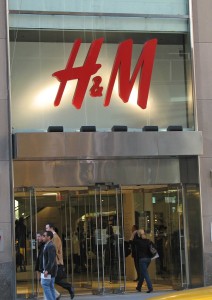Swedish clothing retailer H&M has expressed a desire to set up a production facility in Ethiopia, prompting fears that the Horn of Africa nation could become the next Bangladesh.
Ethiopia’s economy just keeps growing – since 2007 at times with double-digit leaps and bounds. “The Economist” projects that the country will experience annual growth of 7 to 8 percent up to 2016 at least.
Ethiopia’s government is apparently placing special emphasis on the textile industry – by 2016, the country aims to export more than a billion dollars worth of apparel. Factories established by the likes of H&M are more than welcome.
According to a supplier, the Swedish chain wants to produce more than a million items of clothing per month in the East African nation. A company spokesperson confirmed that test runs have already been ordered from Ethiopian producers.
Many producers have in the past relocated production to countries that offered cheap labour, like Bangladesh or China. But social standards and wages have risen in these countries, while the world seems to be examining production conditions increasingly critically. This has led producers to begin considering new options for cheap labour.
On the African continent, Morocco and Tunisia are known as clothing production countries, mostly for discount apparel. Other African countries, like Ghana or Kenya, don’t play much of a role in the fashion industry, according to GermanFashion, a German industry association.
Ethiopia offers a number of advantages, said Thomas Ballweg, a procurement and technical consultant at GermanFashion. “On the one hand are the lower costs – much lower than in China – with 80 million people living there. And, it’s near the sea – and quick to get to Europe via the Suez Canal,” Ballweg said.
This could shorten delivery time by a third compared with coming from the Far East. In addition, Ethiopia’s climate and that of neighbouring countries is well-suited for the cultivation of cotton, Ballweg emphasised. As long as the cotton was of high enough quality, clothing producers could save on expensive import by using local materials.
Apart from H&M, British supermarket chain Tesco and Ireland-based discount textile company Primark also produce in Ethiopia, according to GermanFashion. Observers warn that Ethiopia could become another Bangladesh, with textile factory workers labouring under scandalous conditions. Reports recur of Bengali factories burning down and causing numerous deaths. In April a textile factory in Bangladesh collapsed, killing more than a thousand people.
Christoph Kannengiesser of the German-African Business Association says he can’t imagine such a fate for Ethiopia – even discount apparel companies like H&M or Primark are concerned about their reputation.
“For a company with a brand name that relies on its clientele’s approval, it would be a disaster for it to become known that social or environmental standards are not being kept,” Kannengiesser said.
He said standards set by the International Labour Organisation and World Trade Organisation are high enough, adding that that numerous non-governmental organisations and other independent groups monitor production conditions in countries with cheap labour.
Unlike in the electronics industry, workers in the textile industry do not need to be highly qualified, which Kannengiesser pointed out, allows members of lower social classes a working future – a benefit to all of society in the long term.
“The more people who are working – and the more people who are able to feed themselves, pay for health care and education for their children – the better the chances are for the educational level of society to increase,” Kannengiesser said.
He pointed to such developments in Asia, which were only made possible by investment in the textile industry.
Ethiopia’s textile industry goes back to 1939, when the first factories were established during Fascist Italy’s occupation of the country. During the Cold War, foreign communists collaborated with Ethiopia’s then communist government in the textile sector. Some of those plants are still in service. But the country’s infrastructure is poor: Roads are bad and only 15 percent of the population has electricity.
H&M has said that it does not intend to reduce or close production at locations in Asia. And GermanFashion doesn’t think that Ethiopia will develop into a new textile hub – the country’s production is far too small relative to global production.
H&M first opened for business in Sweden in 1947. The company has since risen to become the world’s second largest clothing retailer.










